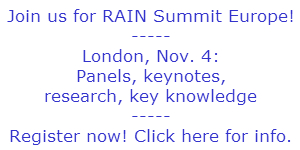 Yesterday we talked to Gordon Borrell of Borrell Associates about his startling and provocative webinar prediction that in 10 years half of AM/FM terrestrial stations will disappear, their demise driven by connected cars and digital dashboards. (Read it here.)
Yesterday we talked to Gordon Borrell of Borrell Associates about his startling and provocative webinar prediction that in 10 years half of AM/FM terrestrial stations will disappear, their demise driven by connected cars and digital dashboards. (Read it here.)
During Monday’s webinar, Borrell made other predictions. One of them, which generated some buzz in the Q&A session, was about programmatic advertising platforms.
Broadly speaking, programmatic is buying and selling of ad inventory on software platforms, targeting audience segments and listener attributes across brands. Programmatic offers buyers efficiency, pricing control, scale, and automation. One common question asked by station managers and audio publishers considering putting their inventory into programmatic platforms is: What about sales reps?
“The universe of about 80,000 advertising sales reps in the United States will dramatically change.” –Gordon Borrell
Gordon Borrell’s projection pins that question to the wall: Programmatic will take over by 2024, and nearly all human sales reps will be gone.
“The whole mechanism of programmatic advertising will eventually lead to a day when we don’t have sales reps — or many sales reps — as we know them,” Borrell told RAIN in a phone call. “It’s a mechanized process of buying.”
 Borrell said that some sales pros will face a shifting role. “The sales reps will be converted to advertising managers. They will manage the buy, try to influence larger networks, and maybe they’ll have their own network. The whole universe of about 80,000 advertising sales reps in the United States really does dramatically change.”
Borrell said that some sales pros will face a shifting role. “The sales reps will be converted to advertising managers. They will manage the buy, try to influence larger networks, and maybe they’ll have their own network. The whole universe of about 80,000 advertising sales reps in the United States really does dramatically change.”
In the spirit of Monday’s webinar, in which Borrell walked his audience through a 20-year history lesson of technology disruptions in media, he made a historical comparion while talking to RAIN: “I equate it to the newsroom of a newspaper. In the 1980s, the newsroom was bustling. It was packed with people coming and going, writing, editing. You go there today — it looks like a library. The same thing will happen here [with radio sales depratments]. In 10 years, these large staffs of 10, 20, 30 sales reps, might diminish by two-thirds, and the role of those who remain will be very different.”

This assumes that the state of the art of advertising will remain as text, banner ads and :30 second video/audio spots. And that advertisers are happy with impressions and clicks as the right way to measure performance. Those formats and metrics won’t go away. But, smarter media outlets/publishers are expanding their advertising formats to longer form advertiser content and they’re delivering leads and sales to their advertisers directly. The game is no longer about impressions, reach and audience demographics. It’s about generating sales for clients by marketing offers to the right contacts at the right time. Media companies can do this without relying completely on programmatic ad networks, who still don’t really enable the long tail of advertisers.
Longer form content is better for the advertiser and the potential buyer since it explains the value of a product/service more fully. But, longer form content requires more production effort and can’t be delivered via an exchange, only promoted by it. You also can’t automate a human’s ability to understand how a product or service is differentiated; nor the creation of the creative messages that communicate that differentiation (especially if it’s longer form). You also can’t really communicate differentiation in 5 words, a few pixels or :30 seconds of air time. Today, there is no reason to produce an ad that doesn’t lead to longer form content and offers. Yet, that’s exactly what radio stations, newspapers and tv stations are still doing.
Smart marketers are spending as much time on their own conversation paths as they do their ad campaigns; the stuff that happens after the click and after the initial consumer opt-in. Smart media outlets and publishers are enabling this too; they are creating full campaigns and conversion paths. They’re sending targeted offers based on what they know about individuals from their own owned database, across multiple channels including web, social, email and mobile assets, and driving conversions for advertisers as a result. They’re creating and distributing longer form advertiser content in order to differentiate their offerings. And it’s working: they’re predictably driving leads and sales for their advertisers. We have radio stations connecting offline sales directly to promotional campaigns at the individual level, newspapers turning print advertisers into bigger digital dollars by leveraging offline and online reach to drive online conversations; B2B publishers increasing their CPLs by providing more qualified “ready-to-buy” leads to advertisers.
We believe that the bigger trend is the convergence of marketing and advertising, and how that enables media companies and agencies to drive ROI for advertisers. Programmatic will certainly eat the margins (and shrink the sales teams) of media outlets that don’t change their offerings. But, they can cement their position by expanding their digital offerings to include longer form content.
I don’t get paid to make predictions. But, we believe that the agencies, radio stations, newspapers of the future will differentiate by running campaigns that produce ROI for advertisers. In fact, we’re seeing media companies rapidly growing digital revenue by embracing long form content, investing in their own technology, and by delivering measurable advertiser ROI.